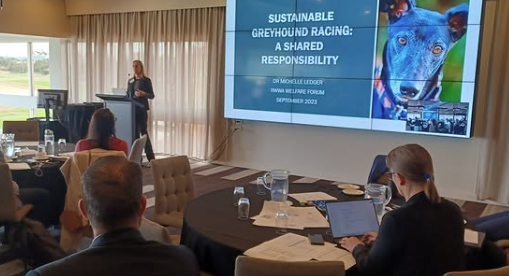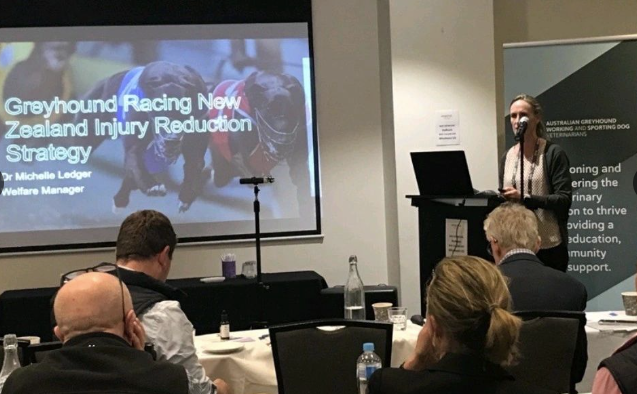SIG in the Spotlight: Australian Greyhound, Working and Sporting Dog Veterinarians
21 Mar 2025
In this edition of SIG in the Spotlight, AGWSDV President Dr Michelle Ledger shares insights into some of the complex issues in this field, with GPs seeing increasing numbers of these breeds as they retire into the community.
What motivated you to become President? How long have you been an AVA member?

I have been an AVA member since I moved to Australia in 2013 and my main motivation in accepting a nomination from the previous President for this position was the desire to lead our member veterinarians in an area which is not well represented in mainstream veterinary practice or University curricula. The greyhound industry has received a lot of negative publicity of late and that puts additional strain on our member veterinarians who work hard each day to ensure these canine athletes are in top shape to compete, who look after them at the track while they’re racing, or make sure they’re healthy and able to live the balance of their lives as pets in retirement. I wanted to unite members for a common cause and make sure everyone felt supported.
Can you tell us about the AGWSDV and its objectives?
The SIG started in 1985, and its core aim is to promote veterinary knowledge and scientific research aimed at improving the health and welfare of racing greyhounds.
We liaise with owners and trainers where needed to provide advice, and education, to ensure they stay informed of evidence to support best-practice.
To liaise with racing controlling bodies where needed, and act as a conduit between regulatory racing bodies and our members so that everyone remains current in Policy and Rules affecting greyhounds.
To be a sensible voice on greyhound matters when required by the AVA.
What type of members typically join the group, and how does it benefit them?
Our Members are typically:
- Regulatory veterinarians employed by racing controlling bodies who manage the health and welfare of greyhounds on and off the track during racing and are ‘the voice’ for the racing (and breeding) greyhounds while upholding the Rules of racing.
- Veterinarians who are passionate about greyhound sports medicine and the management of racing injuries, specific greyhound exercise physiology and medicine. Many of these vets also treat injuries in other sporting and working breeds.
- Veterinarians who are involved in greyhound (and other working and sporting breeds) Orthopaedic Surgery, rehabilitation and physiotherapy.
- Veterinarians involved in canine reproduction, artificial insemination and breeding work for greyhounds, and other sporting dogs.
- Some veterinarians in university settings teaching and publishing research.
- Young veterinarians who have an interest in racing greyhounds or sporting dogs and wish to learn from more experienced greyhound vets
The SIG is collegiate and enjoys an email forum of veterinarians around the world, some who have published research into greyhound medicine and surgery. There is a regular exchange of information on current medical, surgical or behavioural cases, not just limited to greyhounds but also involving often difficult injuries to other sporting or working breeds.

Dr Michelle Ledger, speaking at a greyhound animal welfare forum, 2023
What are some of the key issues that veterinarians working with greyhounds, working and sporting dogs face?
Our members are faced with a low fee-base to support clients who have multiple animals in training, racing and breeding. Days are varied and sometimes there is reluctance of trainers to utilise veterinarians, this is where education and good communication is valuable. Many members have long-standing relationships with people who are clients for many years. Greyhound trainers are religious about the vets they prefer to use and trust. This is an off-shoot of the poor image of trainers and industry of large and one can see how this attitude can be counter-productive in getting these dogs looked at.
Trainers are often knowledgeable and can manage and treat simple injuries but lack contemporary knowledge sometimes, however, they are not the regular pet owner in their level of knowledge, in a similar way to horse trainers. Veterinarians have to demonstrate their understanding and ability to handle these dogs and diagnose often subtle injuries, and have very good examination and palpation skills to gain trust.
One of the greatest challenges is the lack of tertiary-level teaching in sports medicine and surgery or anything greyhound specific. Our SIG is creating a textbook of common greyhound injuries and conditions for the GP veterinarian to assist them to manage retired greyhounds in the community, which are now so popular. It is likely that most small animal vets treat a few here and there these days.
The perceived poor social licence of the greyhound industry is a challenge of its own and adding to the mental burden of our members is constant uncertainty around the future of the industry.

AVA AGWSDV Conference, Melbourne 2023
What plans does AGWSDV have this year?
We have our conference in mid-October in Melbourne. This year we are excited to spend time with the Pig Veterinarian SIG with shared conference facilities and dates.
There is a planned Greyhound Sports Medicine conference in Dublin, Ireland organised by the Irish Racing Board in August and many of our SIG members are speaking or attending that.
Our regulatory veterinary members are looking forward to the bi-annual International Group of Specialist Racing Veterinarians (IGSRV) conference in Melbourne in February 2026, which will feature “synergy among species” and include, among the many equine streams, greyhound specific streams and panels.
Also, continued email forum sharing of knowledge and case information.
How does the SIG support veterinarians in improving their skills in areas like sports medicine and rehabilitation?
Conferences and webinars. We circulate information regarding potential training opportunities and have collaborated with Australian Reproduction Veterinarians (ARV) on TCI training for our reproduction members.
Any emerging trends that or challenges currently affecting these groups of dogs that vets should be aware of?
With the numbers of retired dogs in the community now, veterinarians are more often seeing these animals in private clinics. Greyhounds have unique anatomical, and physiological differences to other breeds of dogs which private practice GPs should be aware of (not to mention their quirky behaviours). Our SIG would love to assist GP veterinarians who have questions, and we have had a series of lectures aimed at addressing this during AVA national conferences - come to Sydney!
Active anti-racing activists can target veterinarians who treat greyhounds, a deplorable act which threatens the welfare of greyhounds, or we have fewer veterinarians willing to see these wonderful dogs.
What advice would you give to veterinarians who are new to working with these breeds?
Seek advice from veterinarians in the field and work with them for a time to gain skills. Refer to past AGWSDV conference proceedings. Attend a few race meetings and work with the On Track Vet. Watch this space for the launch of our textbook on all things greyhound.
